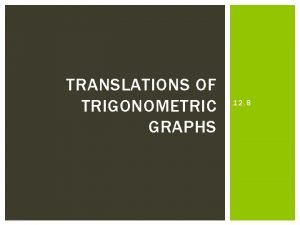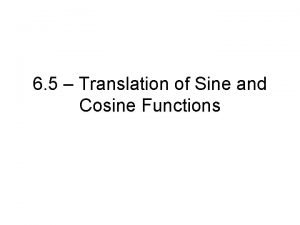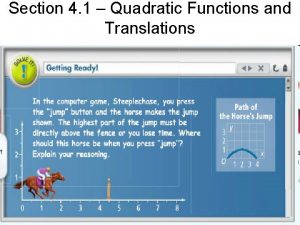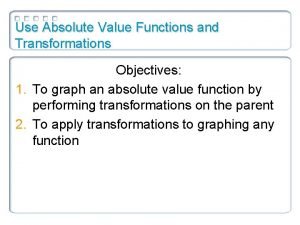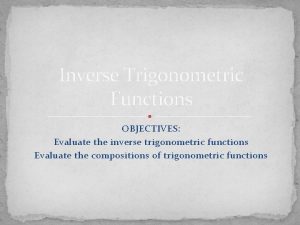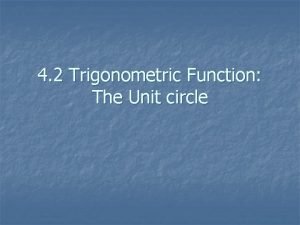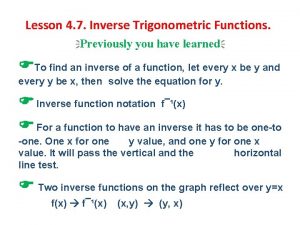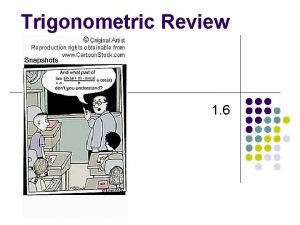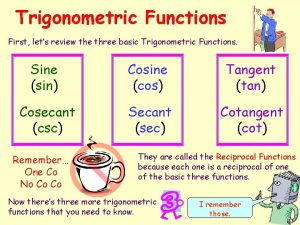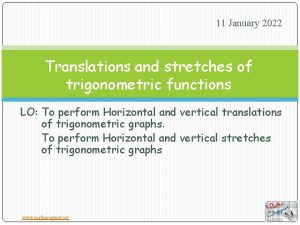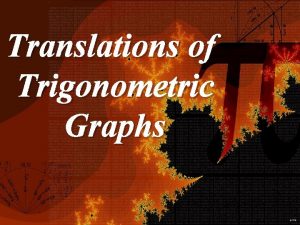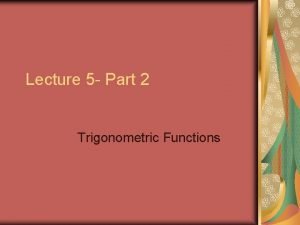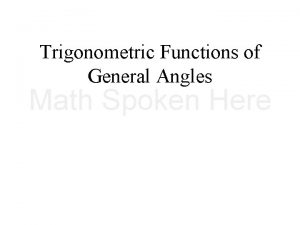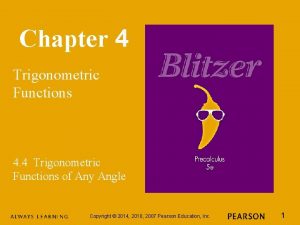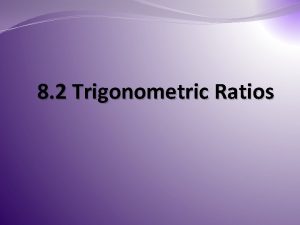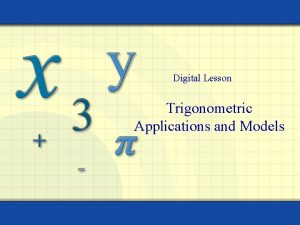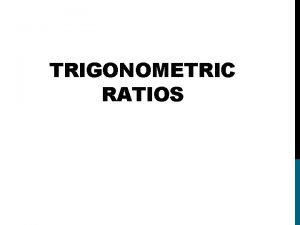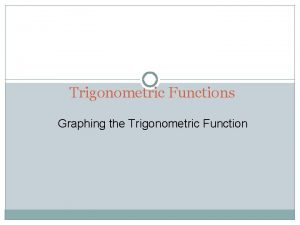Translations and stretches of trigonometric functions Translations We






















- Slides: 22

Translations and stretches of trigonometric functions

Translations We have seen before that the following are translations of a function f (x) + d translates f (x) vertically a distance of d units upward f (x) – d translates f (x) vertically a distance of d units downward f (x + c) translates f (x) horizontally c units to the left f (x – c ) translates f (x) horizontally c units to the right. These functions 1 y y = sin x have a period of 0 -2 p -p 2 p x These functions have an amplitude of 1 -1 1 -2 p -p 0 -1 y y = cos x p 2 p x

Translations The graphs of these function can be transformed in the same way that you transformed the graphs of other functions If f(x) = sin (x) f (x) + d translates f (x) vertically a distance of d units upward Draw f(x) = sin (x) +2 y 3 f(x) = sin (x) + 2 2 1 -2 p -p 0 -1 -2 f(x) = sin x p x 2 p

Translations The graphs of these function can be transformed in the same way that you transformed the graphs of other functions If f(x) = sin (x) f (x) – d translates f (x) vertically a distance of d units downward Draw f(x) = sin (x) – 1 y 3 2 1 -2 p -p 0 f(x) = sin x p x 2 p -1 -2 f(x) = sin (x) – 1

Translations The graphs of these function can be transformed in the same way that you transformed the graphs of other functions If f(x) = sin (x) f (x + c) translates f (x) horizontally c units to the left y 3 2 1 -2 p -p 0 -1 -2 f(x) = sin x p x 2 p

Translations The graphs of these function can be transformed in the same way that you transformed the graphs of other functions If f(x) = sin (x) f (x – c) translates f (x) horizontally c units to the right y 3 2 1 -2 p -p 0 -1 -2 f(x) = sin x p x 2 p

Translations The graphs of these function can be transformed in the same way that you transformed the graphs of other functions If f(x) = cos (x) f (x) + d translates f (x) vertically a distance of d units upward Draw f(x) = cos (x) +2 y 3 f(x) = cos (x) + 2 2 1 -2 p -p 0 -1 -2 f(x) = cos x p x 2 p

Translations The graphs of these function can be transformed in the same way that you transformed the graphs of other functions If f(x) = cos (x) f (x) – d translates f (x) vertically a distance of d units downward Draw f(x) = cos (x) – 1 y 3 2 1 -2 p -p 0 f(x) = cos x p x 2 p -1 -2 f(x) = cos (x) – 1

Translations The graphs of these function can be transformed in the same way that you transformed the graphs of other functions If f(x) = cos (x) f (x + c) translates f (x) horizontally c units to the left y 3 2 1 -2 p -p 0 -1 -2 f(x) = cos x p x 2 p

Translations The graphs of these function can be transformed in the same way that you transformed the graphs of other functions If f(x) = cos (x) f (x – c) translates f (x) horizontally c units to the right y 3 2 1 -2 p -p 0 -1 -2 f(x) = cos x p x 2 p

Translations We can combine horizontal and vertical translations by looking at equations in the form f(x) = sin (x + c) + d f(x) = cos (x + c) + d f(x) = tan (x + c) + d Sketch f (x) = sin x In the same set of axis sketch the graph (a) f(x) = sin (x) + 1 y The function is shifted 1 unit upward. 3 2 f(x) = sin x 1 x -2 p -p 0 -1 -2 p 2 p

Translations Write a sine equation for the following function The function f(x) = sin (x) is shifted 3 units down. So, the equation is f(x) = sin (x) – 3 y 3 -2 p -p 0 -1 -2 -3 -4 p 2 p x

Translations Write a cosine equation for the following function y 3 2 1 x -2 p -p 0 -1 -2 p 2 p

Vertical stretches We have seen before that when a function undergoes a stretch af (x) stretches f (x) vertically with scale factor a The function f(x) = asin x is the vertical stretch of f(x) = sin x The function f(x) = acos x is the vertical stretch of f(x) = cos x If a > 1, the function will appear to stretch away from the x -axis. If 0 < a < 1, the function will appear to compress closer to the x-axis. If a < 0, the function will also be reflected over the x-axis. With the vertical stretch, the amplitude of the sine or cosine function will change from 1 to |a|. The period of the function will not change.

Vertical stretches When the graph of a function undergoes a vertical stretch, every y-value in the original function is multiplied by the value of a. If f(x) = sin (x) Draw f(x) = 3 sin (x) The sine curve has been stretched vertically by a factor of 3 y 3 The maximum f(x) = 3 sin (x) values are at 2 y=3 f(x) = sin (x) The minimum 1 values are at y x = -3 -2 p -p p 0 2 p The amplitude -1 of the new function is 3 -2 The period is -3 2 p

Vertical stretches When the graph of a function undergoes a vertical stretch, every y-value in the original function is multiplied by the value of a. If f(x) = sin (x) Draw f(x) = 0. 5 sin (x) The sine curve has been stretched vertically by a factor of 0. 5 y 3 The maximum values are at 2 y = 0. 5 f(x) = sin (x) The minimum 1 f(x) = 0. 5 sin (x) values are at y x = -0. 5 -2 p -p p 0 2 p The amplitude -1 of the new function is 0. 5 -2 The period is -3 2 p

Vertical stretches When the graph of a function undergoes a vertical stretch, every y-value in the original function is multiplied by the value of a. If f(x) = sin (x) Draw f(x) = -2 sin (x) The sine curve has been stretched vertically by a factor of -2 y 3 The maximum f(x) = -2 sin (x) values are at 2 y=2 f(x) = sin (x) The minimum 1 values are at y x = -2 -2 p -p p 0 2 p The amplitude -1 of the new function is 2 -2 The period is -3 2 p

Horizontal stretches We have seen before that when a function undergoes a stretch The functions f(x) = sin (bx), f(x) = cos (bx), f(x) = tan (bx) represent horizontal stretches of sine, cosine and tangent functions. We can also say that every x-value in the original function is divided by b.

Horizontal stretches Multiplying or dividing the x-values by a number in this way changes the period of a trigonometric function. If b > 1, the period will be shorter, and the function will appear to compress toward the y-axis. If 0 < b < 1, the period will be longer, and the function will appear to stretch away from the y-axis. If a < 0, the function will also be reflected over the y-axis.

Vertical stretches If f(x) = sin (x) Draw f(x) = sin (2 x) The sine curve has been stretched horizontally by a factor of 0. 5 The maximum values are at y=1 The minimum values are at y = -1 The amplitude has not changed y 3 2 f(x) = sin (2 x) f(x) = sin (x) 1 x -2 p -p 0 -1 -2 -3 p 2 p

Vertical stretches If f(x) = cos (x) Draw f(x) = 2 cos (3 x) and vertically by a factor of 2 The maximum values are at y=2 The minimum values are at y = -2 The amplitude has changed, it is 2 y 3 2 f(x) = 2 cos (3 x) f(x) = cos (x) 1 x -2 p -p 0 -1 -2 -3 p 2 p

Vertical stretches If f(x) = tan (x) Draw f(x) = tan (2 x) The tangent curve has been stretched horizontally by a factor of 0. 5 f(x) = tan (x) y f(x) = tan (2 x) 3 2 1 x -2 p -p 0 -1 -2 -3 p 2 p
 3-3 transforming linear functions
3-3 transforming linear functions Concept
Concept 12-8 skills practice translations of trigonometric graphs
12-8 skills practice translations of trigonometric graphs Horizontal phase shift
Horizontal phase shift Stretches for discus throwers
Stretches for discus throwers Major landforms in europe
Major landforms in europe A large landform
A large landform Adductor stretches for runners
Adductor stretches for runners Chin flexion
Chin flexion Supinator muscle nerve supply
Supinator muscle nerve supply It stretches from mahanadi valley to nilgiris in the south
It stretches from mahanadi valley to nilgiris in the south Translations quadratic functions
Translations quadratic functions Transformations of linear and absolute value functions
Transformations of linear and absolute value functions Trigonometric functions domain and range
Trigonometric functions domain and range Trigonometric functions domain and range
Trigonometric functions domain and range Inverse circular functions
Inverse circular functions Unit circle radians
Unit circle radians How to find inverse of a function
How to find inverse of a function Cos90
Cos90 Three basic trigonometric functions
Three basic trigonometric functions Sine cosine partner
Sine cosine partner How to find period in sine function
How to find period in sine function 12-7 graphing trigonometric functions answers
12-7 graphing trigonometric functions answers


